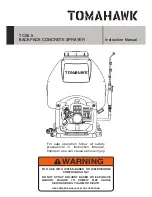
- 17 -
!
!
WARNING! Any internal overhaul or
maintenance must only be performed by an
authorised service centre.
Cleaning the gun (FigH, Fig.L)
!
!
WARNING! The gun must always be cle-
aned carefully immediately after use. If the
paint dries inside it will be very difficult to
clean and there is a risk of not being able to
use it again.
!
!
WARNING! Do not use inflammable sol-
vents to clean the gun. Clean the gun in a
well ventilated room, in accordance with the
general safety standards and electrical safety
standards indicated above.
Switch off the appliance and disconnect the
motor body (2 Fig.F7) from the spraying unit
(1 Fig.F7).
Remove the tank (1 - Fig. G) having made sure
that all the coating material in the gun has flowed
back into the tank. Pour the remaining paint into
its tin and close it tightly.
Begin cleaning the tank by pouring a small
amount of diluents into it that is suitable for the
type of paint involved and that has a flash point
of more than 21°C.
Shake the tank with the diluents for a few se-
conds and then empty it. Repeat this operation
until the diluents that are poured out of the tank
are properly clean. Clean all traces of paint from
both the inside and the outside of the tank.
Clean the gasket under the tank cap (19 Fig.L),
and check that it is not worn or damaged.
To clean the other gun components proceed as
follows (Fig.H, Fig.L):
!
!
Warning! The gun contains many small
components that can be easily lost and must
be perfectly reassembled in the correct
sequence after removing them for cleaning.
Store or photograph the components to
prevent the gun from being used after their
replacement.
Swirl the ring (11 Fig.H) and remove the com-
ponents. Do not force any component with tools
and do not use compressed air.
Put all the dismounted pieces in a receptacle
and proceed to clean them using clean diluents
(perhaps recommended by the paint manufac-
turer), and use a paintbrush.
Also clean the inside parts of the gun and the
suction tube using the supplied accessories
(Fig.L).
Before fitting these components again make sure
they are properly dry.
Warning!
Replace the components listed fol-
lowing the removal sequence in reverse order.
Cleaning the machine casing
Switch the machine off and disconnect the
battery.
Clean the machine casing with a soft brush or
clean damp cloth. Do not use any detergents
or solvents as these may damage the machine
beyond repair. The plastic parts are prone to
damage by chemical agents.
!
!
Always keep the ventilation holes (3 Fig.A)
clean and free.
Warning!
Do not spray or soak the machine
with water.
For maintenance not explained in these instruc-
tions, contact an authorised assistance centre.
STORING
- After each use clean the entire machine and all
its accessories properly (see the Maintenance
paragraph). This will prevent mildew from
forming, which will ensure better performance
and a longer working life.
- Keep the machine out of reach of children, in a
stable safe position, in a dry place not subject
to extreme temperatures and free of dust.
- Protect the machine from direct sunlight,
keeping it in the dark where possible, or in the
shade.
- Do not wrap the machine in plastic bags as
dampness could form.
DISPOSAL
In order to protect the environment, proceed
according to the local laws in force. Contact the
relevant authorities for more information.
When the machine is no longer usable or repai-
rable, take the machine and its packaging to a
recycling centre.
Electric and electronic waste may contain
substances hazardous to the environment and
human health. It should therefore not be dispo-
sed of with household waste, but by means of
separate collection at special collection centres
or returned to the vendor in the event of purcha-
sing a new similar tool. Illegal disposal of waste




































